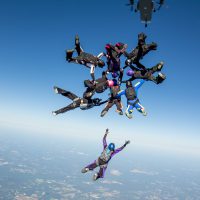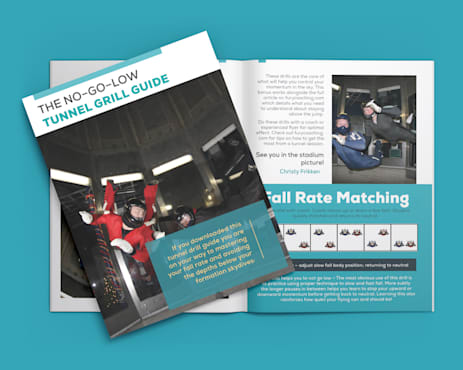Don’t just sit there, fly on the hill!
Monday, April 12, 2021

Are you still holding the exit before starting the skydive? Want to start making points sooner? Read on to learn what the hill is and how to navigate it more effectively!
Hill? What hill?
The hill is the time in your skydive that you accelerate to terminal velocity. When you first leave the plane, you are subject to wind coming from the prop’s direction, since the plane is moving forwards. As gravity takes effect, you stop experiencing that wind and start moving downward.
This transition happens gradually for the first 5 seconds or so of your jump. The effect looks like sliding down a hill. Relative to other jumpers, it will feel harder to move back up to the plane, just like a hill.
Same old wind, different direction
In terms of control, you always want your presented surface (for formation skydiving, your hips) pointed right at the wind. The instant you leave the plane, the wind is coming from the front of the plane. Eventually, this shifts to the earth. No matter where you are on the hill, you can move and fly in all the same ways you can “belly-to-earth.” You are just flying on a different surface/plane of wind.
Cut. It. Out!
A common term when debriefing exits is “getting cut.” Getting cut means mis-presenting yourself to the relative wind, and is easy to do on the hill accidentally.
If you were in the middle of your jump and you rolled a shoulder suddenly into the wind, you would expect to lose altitude and slide away. If you dip part of your body like that into the plane of wind while you are on the hill, the effect is similar. You will lose altitude and slide away relative to the other jumpers.
If you have ever gone “instantly low” immediately after an exit, this could be the culprit. You might not realize you are cut, and when the group flattens out from the hill, you will suddenly notice you are drastically off level.
Relative to each other
The visuals of the hill can take some getting used to! Falling sideways seems like a weird MC Escher thing. As you’re learning, keep your attention to your team or group and focus on staying on the same sheet of wind as they are. Staying focused on each other will help you stay close and start moving sooner.
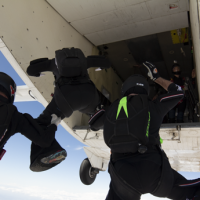 |
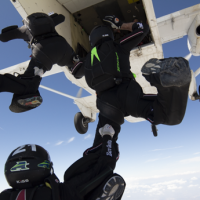 |
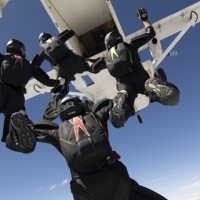 |
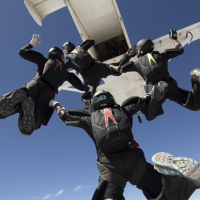 |
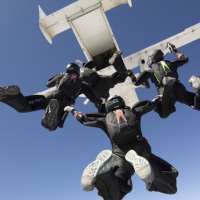 |
 |
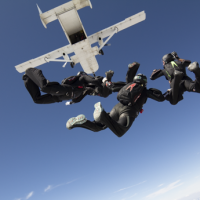 |
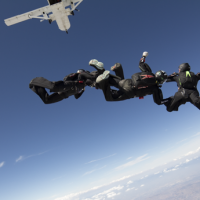 |
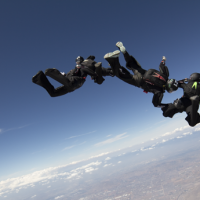 |
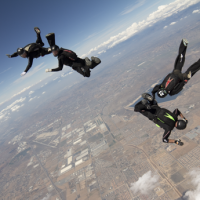 |
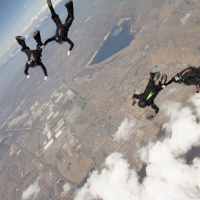 |
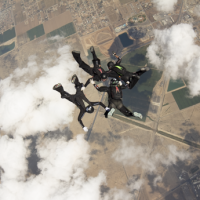 |
Feeling wind
To back up your group’s visual reference, learn to feel where the wind is coming from. Don’t try to force a sight picture, just let your good body position stay on the wind. With practice, you will feel when you dip the wrong part of your body into the wind.
Less body language
When you start turning and moving on the hill, minimize the body language used to move. If you try to crack that sharp 360 as you would in the tunnel, you will probably end up cut. Instead, try to turn with a minimal amount of body input while doubling down on the referencing. Reducing body language will allow you to stay very presented and close as you slide down the hill.
Push back to the middle
Skydivers tend to get more distance from each other on the hill. After you key the first point, focus on pushing your group’s center close before you start any movement. By paying attention to staying close for a moment before you start, you’ll avoid the spread.
Favor down the hill
It is more challenging to go up the hill than down the hill. If you are on the top side of the hill, expect to fly more towards the downside jumpers to compensate for this effect. Of course, if you are on the downside, be prepared to push hard towards the center to keep your ground!
The hill adds a fun and challenging aspect to formation skydiving. Don’t be afraid to let go and start learning what it means to fly right out the door. The rest of the plane will be watching your exits with oohs and ahhs as you score multiple points just seconds after you leave!
